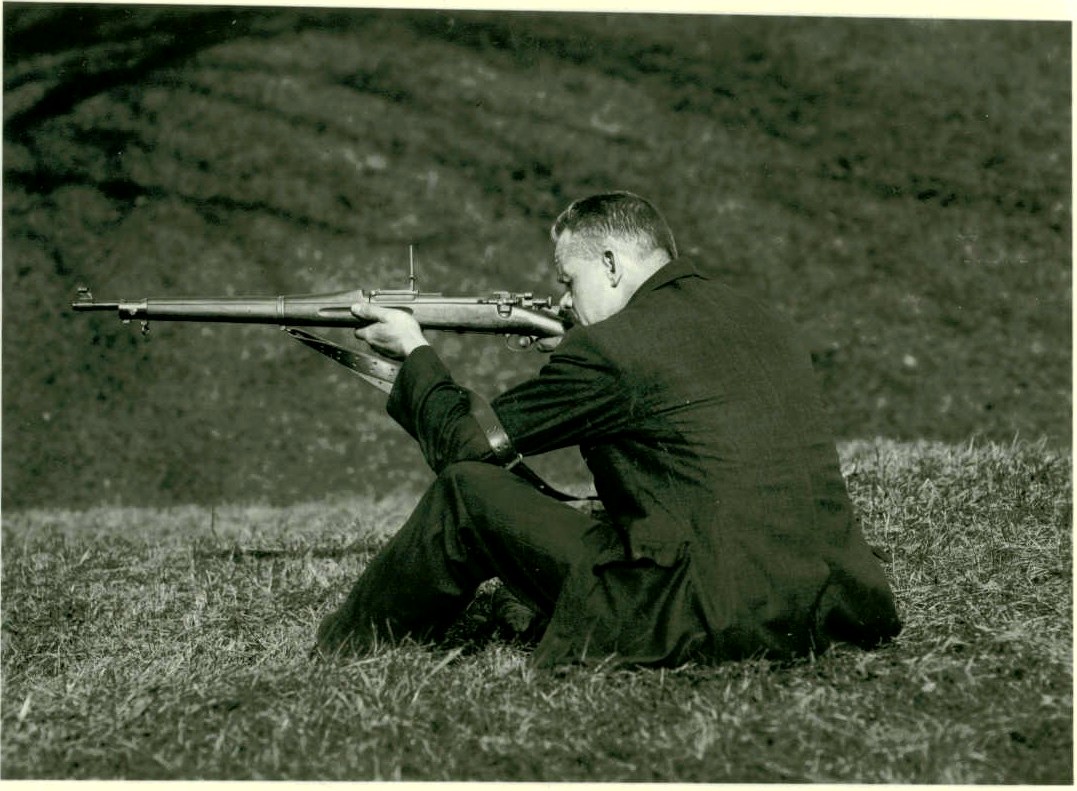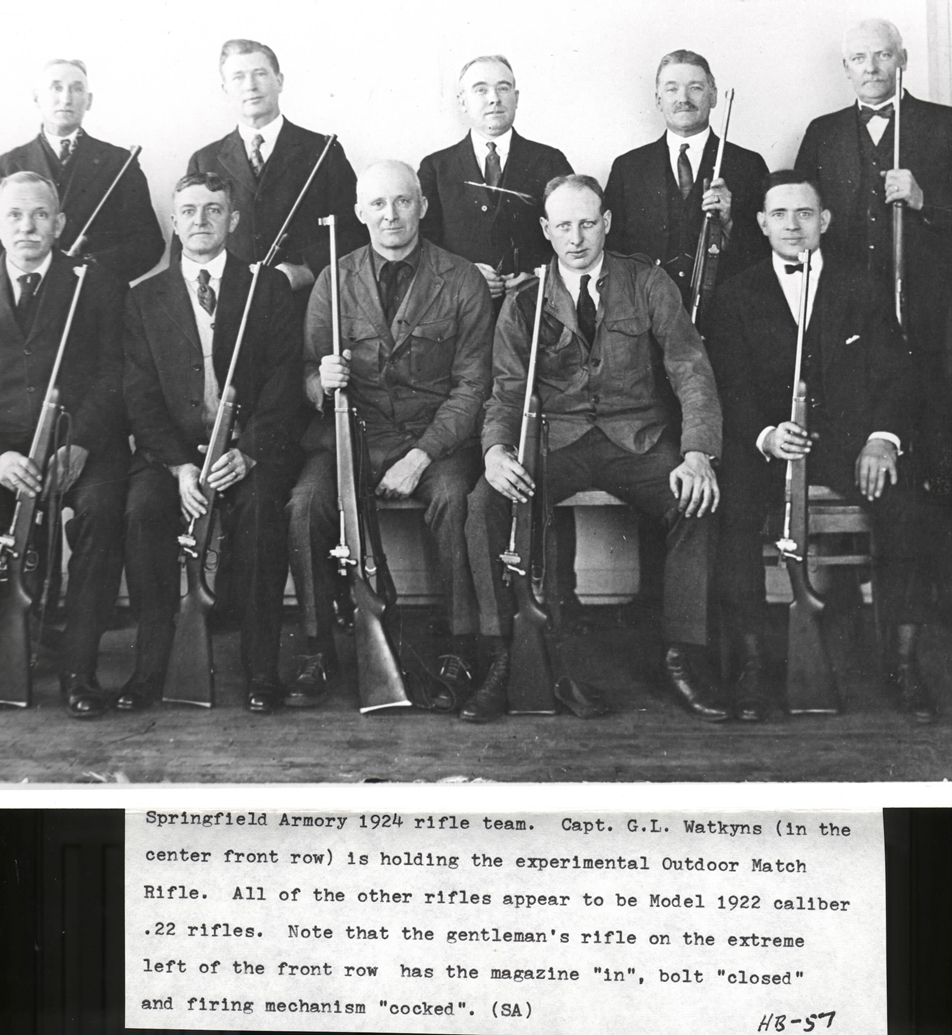|
The first use of the M1903 rifle in National Match competition at Camp Perry
in 1908 also found the M1903 introduced to international competition. Selected
M1903 rifles used by the American International Rifle Team competing at Bisley,
England, that year allowed the Americans to emerge victorious on the 1,000-yard
range. These rifles proved superior to rifles used by all other nations. The
accuracy of the rifles and the skill of the marksmen over the course of fire
from 200 to 1000 yards could not be disputed since the Americans dominated the
match.

A civilians takes aim as he fires off a few rounds from the S.A. Model 1903
Major Winder, a member of the victorious team, stated in an interview given on
July 25, 1908; "We won the match with $16.00 rifles, while the British marksmen
used special arms that cost from $75.00 to $100.00 each."
The 1903 Springfield rifle was admired by members of all the Olympic teams and
they perpetually asked the American team to let them examine their fine rifles.
Colonel Blunt, Commandant of the Springfield Armory stated; "Had the rifles
which the team used come from only the general run of the stock and not selected,
they would still have been the best military rifles in the world and better than
any used at Bisley." The rifle and the U.S. marksmen proved he was right.
The first M1903’s modified with a heavy barrel were used at the 1919 National
Matches held in Caldwell, New Jersey. U.S. teams representing America in international
competition soon took notice and expressed interest in a heavy barrel rifle for
use in the “free rifle” competitions. Springfield Armory provided
the rifles they needed, winning the International Match in 1922, 1923, and 1924.
The ten rifles supplied to the 1921 International Rifle Team’s competition
in Lyons, France, included a 24” heavy barrel set into modified straight
and pistol grip sporting stocks using a Lyman 48 receiver sight. That successful
experience led to an improved long-range rifle designated Rifle, U.S. caliber
.30, Model 1922. Modifications to the stock included a palm rest attachment.
Using one these rifles, Mr. W. R. Stokes won the 1922 World’s Individual
Championship and the World’s Kneeling Championship. Sgt. Morris Fisherm,
USMC, won the DuPont free rifle trophy with this Springfield rifle.

The 1924 Springfield Armory Rifle team poses for a picture.
Springfield Armory’s artisans set their sights higher with approximately
fifty of their Model of 1923 .30” caliber International Match Rifles. Modeled
on the Model of 1922 .30” caliber Match Rifle, these rifles possessed a
longer 26” and 30” heavy barrel and hooded front sight among other
refinements. The Model of 1924 .30” caliber International Match Rifle was
Springfield Armory’s next contribution. Provided with a 30” heavy
barrel (manufactured by Winchester, H. M. Pope, or Remington), Winchester “Globe” front
sight, and Rinkuna double-set trigger, the forty rifles produced included John
Garand’s invention of the “Super Speed Firing Mechanism” that
greatly reduced the “lock time.” [John Garand later created the famed
M1 Garand rifle of WWII fame.1] Earlier International Match Rifles had been handicapped
by relatively long “lock time” when compared to the European competition
using Martini falling-block actions. Garand’s work entirely eliminated
this problem. A dozen Model of 1924 .22” caliber rifles International Match
Rifles were also produced. Except for the smaller bore, these rifles were identical
to the Model of 1924 .30” caliber International Match Rifle and were manufactured
in the record time of fifteen days.
The twenty-five Model of 1927 .30” caliber International Match Rifles produced
by Springfield Armory were similar to the Model of 1924 except for a 28” barrel,
altered palm rest attachment, and Woody double-set trigger. The use of Frankford
Arsenal’s super-accurate custom ammunition assured the best results, yet.
The next year, several especially advanced weapons, designated Rifle, U.S. Caliber
.30, Model 1903, Experimental International Match, were fabricated at Springfield
Armory incorporating adaptations of the best Swiss designs in set triggers and
stock forms.
Throughout the period of development of the Springfield Armory International
Match Rifles, the U.S. Marine Corps played a major role in both setting performance
goals and in participation in the international competitions. The creation of
the Model 1930, International Match Rifle, continued this productive relationship
between the USMC and Springfield Armory. In the continuing search to find a combination
of features possessing the utility and accuracy of the rifles of other nations,
the U.S. Marine Corps had Springfield Armory create several single shot rifles
based on the Model 1903 receiver that outwardly resembled the 1924/1927 rifles.
The next year’s rifle model, made in several stock styles, represented
the final attempt by the U.S. international shooting team to follow Swiss patterns.2
Brophy, William, The Springfield
1903 Rifles, Stackpole Books, Harrisburg, PA, 1985, pp. 105-43.
|